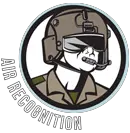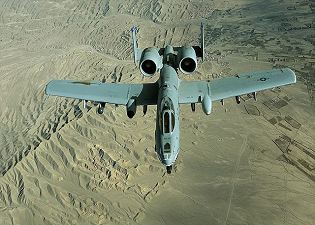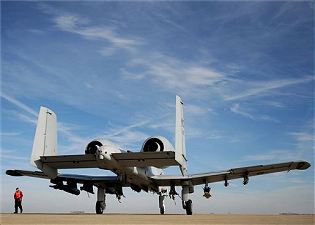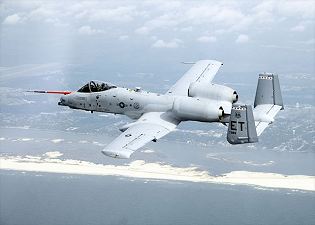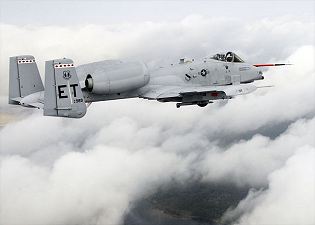| |
||||||||||||||||||||||
| a | ||||||||||||||||||||||
A-10 Thunderbolt II close
air support aircraft |
||||||||||||||||||||||
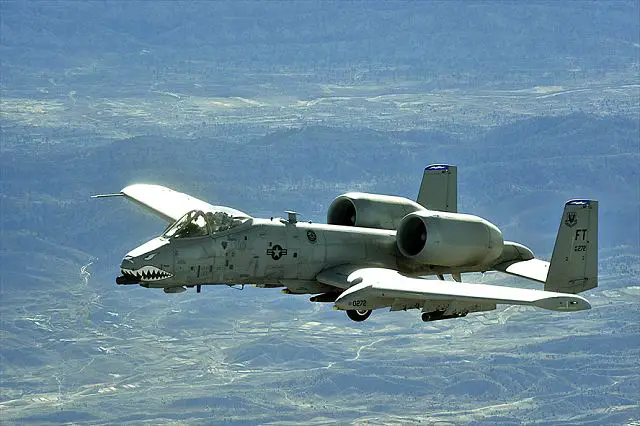 |
||||||||||||||||||||||
| |
||||||||||||||||||||||
The
Fairchild Republic A-10 Thunderbolt II is an American twin-engine, straight
wing jet aircraft developed by Fairchild-Republic in the early 1970s.
The A-10 was especialli dsigned to perform close air support missions,
including attacking tanks, armored vehicles, and other ground targets
with limited air defenses. The first production A-10A was delivered
to Davis-Monthan Air Force Base, Ariz., in October 1975. The upgraded
A-10C reached initial operation capability in September 2007. Specifically
designed for close air support, its combination of large and varied
ordnance load, long loiter time, accurate weapons delivery, austere
field capability, and survivability has proven invaluable to the United
States and its allies. The aircraft has participated in operations Desert
Storm, Southern Watch, Provide Comfort, Desert Fox, Noble Anvil, Deny
Flight, Deliberate Guard, Allied Force, Enduring Freedom and Iraqi Freedom.
The A-10 has received many upgrades over the years. From 1978 onwards,
the Pave Penny laser receiver pod was adopted, which receives reflected
laser radiation from laser designators for faster and more accurate
target identification. The A-10 began receiving an inertial navigation
system in 1980. In 2005, the entire A-10 fleet began receiving the Precision
Engagement upgrades that include an improved fire control system (FCS),
electronic countermeasures (ECM), and smart bomb targeting. Aircraft
which received this upgrade are redesignated A-10C; work was to be completed
in 2011. In 2007, the A-10 was subject to a service life extension program
(SLEP);[28] Boeing was awarded a contract to build as many as 242 A-10
wing sets in June 2007. In 2012, Air Combat Command requested the testing
of a 600-gallon external fuel tank which would extend the A-10's loitering
time by 45–60 minutes; flight testing of such a tank was conducted
in 1997, but did not involve combat evaluation. |
||||||||||||||||||||||
| Main Variants | ||||||||||||||||||||||
-
A-10A: Single-seat close air support, ground-attack version.
(All updated to A-10C) - OA-10A: A-10As used for airborne forward air control. (All updated to A-10C) - YA-10B Night/Adverse Weather: Two-seat experimental prototype, for work at night and in bad weather. The one YA-10B prototype was converted from an A-10A. - A-10C: A-10As updated under the incremental Precision Engagement (PE) program |
||||||||||||||||||||||
| Technical Data | ||||||||||||||||||||||
| Design | ||||||||||||||||||||||
The
A-10 has superior maneuverability at low speeds and altitude because
of its large wing area, high wing aspect ratio, and large ailerons.
The wing also allows short takeoffs and landings, permitting operations
from primitive forward airfields near front lines. The aircraft can
loiter for extended periods and operate under 1,000 ft (300 m) ceilings
with 1.5 mi (2.4 km) visibility. It typically flies at a relatively
low speed of 300 knots (350 mph; 560 km/h), which makes it a better
platform for the ground-attack role than fast fighter-bombers, which
often have difficulty targeting small, slow-moving targets. The leading
edge of the wing has a honeycomb structure panel construction, providing
strength with minimal weight; similar panels cover the flap shrouds,
elevators, rudders and sections of the fins. The skin panels are integral
with the stringers and are fabricated using computer-controlled machining.
The ailerons are at the far ends of the wings for greater rolling moment
and have two distinguishing features: The ailerons are larger than is
typical, almost 50 percent of the wingspan, providing improved control
even at slow speeds; the aileron is also split, making it a deceleron.
The cockpit and parts of the flight-control system are protected by
1,200 lb (540 kg) of titanium aircraft armor, referred to as a "bathtub".The
armor has been tested to withstand strikes from 23 mm cannon fire and
some strikes from 57 mm rounds. It is made up of titanium plates with
thicknesses from 0.5 to 1.5 inches (13 to 38 mm) determined by a study
of likely trajectories and deflection angles. The armor makes up almost
6 percent of the aircraft's empty weight. Any interior surface of the
tub directly exposed to the pilot is covered by a multi-layer nylon
spall shield to protect against shell fragmentation. The front windscreen
and canopy are resistant to small arms fire |
||||||||||||||||||||||
Propulsion |
||||||||||||||||||||||
The
A-10 Thunderbolt is powered by two TF34-GE-100 engines, supplied by
General Electric, each supply 9,065lb thrust. The location of the engines,
high on the fuselage, allows the pilot to fly the aircraft fairly easily
with one engine inoperable. The A-10 can fflight at a maximum speed
of 450 nautical miles per hour (Mach 0.75) with a maximum range of 2580
miles (4,150 km). |
||||||||||||||||||||||
Avionics |
||||||||||||||||||||||
The
A-10 Thunderbolt IIs have Night Vision Imaging Systems, or NVIS, goggle
compatible single-seat cockpits forward of their wings and a large bubble
canopy which provides pilots all-around vision. The A-10 has received
many upgrades over the years. In 1978, the aircraft received the Pave
Penny laser receiver pod, which sensed reflected laser radiation from
a laser designator. Pave Penney has now been discontinued in favor more
capable advanced targeting pods. The A-10 began receiving an inertial
navigation system in 1980. Later, the Low-Altitude Safety and Targeting
Enhancement (LASTE) upgrade provided computerized weapon-aiming equipment,
an autopilot, and a ground-collision warning system. In 1999, aircraft
began to receive Global Positioning System navigation systems and a
new multi-function display. In 2005, the entire A-10 fleet began receiving
the Precision Engagement upgrades that include an improved fire control
system (FCS), electronic countermeasures (ECM), upgraded cockpit displays,
the ability to deliver smart bombs, moving map display, hands on throttle
and stick, digital stores management, LITENING and Sniper advanced targeting
pod integration, situational awareness data link or SADL, variable message
format, or VMF, GPS-guided weapons, and upgraded DC power. The entire
A-10 fleet has been Precision Engagement modified and now carries the
A-10C designation. |
||||||||||||||||||||||
| Armament | ||||||||||||||||||||||
The
primary weapons of the A-10 is the 30 mm GAU-8/A Avenger Gatling-type
cannon which fires large depleted uranium armor-piercing shells. The
gun is loaded by Syn-Tech's linked tube carrier GFU-7/E 30 mm ammunition
loading assembly cart. The pilot could switch between two rates of fire:
2,100 or 4,200 rounds per minute. The cannon takes about half a second
to come up to speed, so 50 rounds are fired during the first second,
65 or 70 rounds per second thereafter. The gun is accurate enough to
place 80 percent of its shots within a 40-foot (12.4 m) diameter circle
from 4,000 feet (1,220 m) while in flight. The GAU-8 is optimized for
a slant range of 4,000 feet (1,220 m) with the A-10 in a 30 degree dive.
The A-10 has 11 stores pylons, providing an external load capacity of
7,260kg. There are three pylons under the fuselage and the loads can
be configured to use either the centre-line pylon or the two flanking
fuselage pylons.The AGM-65 Maverick air-to-surface missile is a commonly
used munition, targeted via electro-optical (TV-guided) or infrared.
Other weapons include cluster bombs and Hydra rocket pods. The A-10
is equipped to carry laser-guided bombs. A-10s usually fly with an ALQ-131
ECM pod under one wing and two AIM-9 Sidewinder air-to-air missiles
under the other wing for self-defense. |
||||||||||||||||||||||
| Specifications | ||||||||||||||||||||||
|
||||||||||||||||||||||
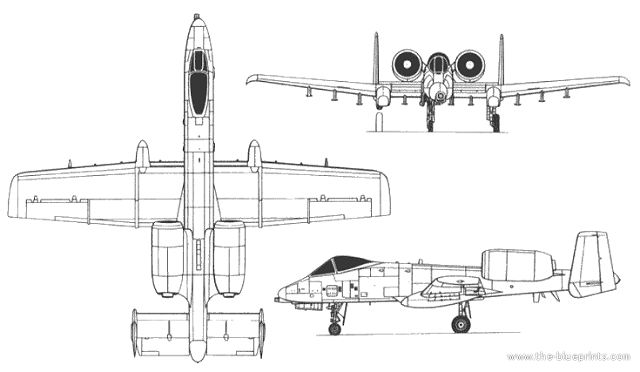 |
||||||||||||||||||||||
|
||||||||||||||||||||||
A-10 Thunderbolt II close air support aircraft technical data sheet specifications intelligence pictures video US USAF United States American Air Force
- Posted On
